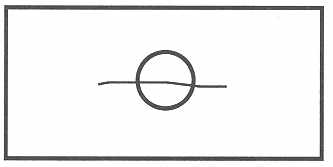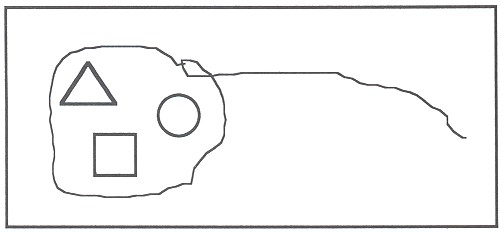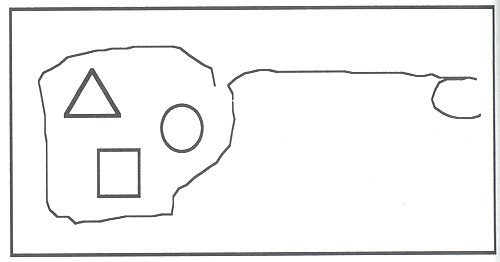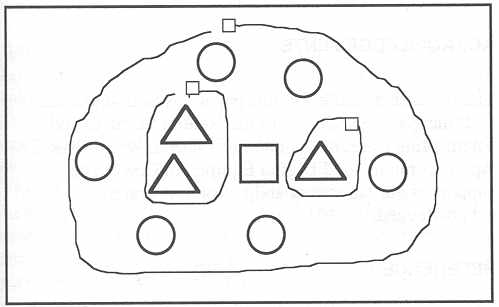
Kurtenbach, G. & Buxton, W. (1991). GEdit: a testbed for editing by contiguous gesture. SIGCHI Bulletin, 23(2), 22 - 26.
GEDIT: A TEST BED FOR EDITING BY CONTIGUOUS GESTURES
GORDON KURTENBACH
BILL BUXTON
GEdit provides a toy world that serves to demonstrate a number of concepts:
This particular toy world was chosen because it is simple enough to
be tractable, yet complex enough to capture a critical mass of real-world
problems (such as one encounters in a CAD or graphical layout program).

Figure 1: Shorthand Symbols for Adding Objects.Three objects can be defined: a square, circle and triangle. These are illustrated using bold lines. Shorthand symbols are used to define which type of object is to be created, and where it is to be placed These are illustrated using thinner lines with arrowheads. Object type is defined by the shape of the shorthand symbol. The specified object is centred on the starting point of the defining symbol.
The object being defined is centered on the starting point from
which the shorthand symbol is drawn. Thus, the symbol defines both shape
and position of the defined object.

Figure 2: Deleting an Individual Object. Individual objects can be deleted by drawing a single horizontal stroke through them The direction of the stroke does not matter.
When the scope includes more than one object, we refer to it as Collective scope. In GEdit, the mechanism for specifying collective scope is circling.
Scoping mechanisms have a large impact on the effectiveness of a system
(Buxton, Patel, Reeves & Baecker, 1981). GEdit provides an opportunity
to explore some not so common aspects of scope specification. These are
illustrated in the examples that follow.

Figure 3: Deleting, a Group of Objects. A group of objects is deleted by circling them and extending the encircling line within the circle.

Figure 4: Moving a Group of Objects. A group of objects is moved by circling them, and extending the encircling line to the new location.The move command confronts us with two important points worthy of discussion:

Figure 5: Copying a Group of Objects. A group of objects is copied by circling them, and extending the encircling late to the new location, and drawing a "C" (for copy) gesture.
In such cases, the scope is first specified using a circling gesture. as illustrated in Figure 6.

Figure 6: Specifying Scope Alone. Scope can be specified without specifying an operator. In this case, by way of feed-back, the system provides a graphical "handle" in the way of a small square at the end-point of the circle. The Delete, Move, or Copy gestures can then be articulated as long as the command portion is started in the box handle.In this case, where no command accompanies the specification of the scope, feedback is provided by way of a small box appearing of the end of the encircling line. This box is like a "handle" on the scope. Having thus specified the scope, one can then invoke the delete, move or copy operator by drawing the command part of the gesture, starting within this "handle."
The prime reason that GEdit included the independent specification of scope, as discussed in the previous section, was to provide a means whereby some objects within the specified region could be excluded from being operated upon.
This is made possible by enabling circles of exclusion as well as inclusion. This is illustrated in Figure 7.

Figure 7: Specifying noninclusive scope. Circles of both inclusion and exclusion can he specified The outermost circle is always inclusion. Circles within circles toggle between exclusion and inclusion. In the example, all objects are selected except for the triangles.This technique is useful in cases where the objects to be operated on have a high degree of spatial coherence, but where there are other objects also in the same area. In the example illustrated in Figure 7, for example, the intention is to operate on all objects except for the triangles. Deleting the intended objects could, for example, be accomplished by drawing a stroke starting from the outermost circle's "handle" and terminating anywhere within.
Choice of symbol: Unlike menu-based systems, this class of interface is not self-revealing It is not always obvious what commands are possible or how to invoke them. As the repertoire of commands grows, so does the problem of remembering the symbols that invoke them. Graphical mnemonics can help the situation through the use of symbols that have some graphical correspondence with what they represent.
In GEdit, for example, this is the case with the triangle symbol. On the other band, this is not the case with the symbols for the square and circle, which were chosen for the speed with which they could be input. The program confronts us with the potential conflict between optimizing two aspects of human performance: memory and execution time.
Input device: The majority of studies of input technologies have focused on a limited number of tasks, especially pursuit tracking and target acquisition. These studies do not provide us with much information about how well various technologies can support the "line-drive" type of interface demonstrated in GEdit
One advantage to the Macintosh version of the program is that it is very easy to change input devices for the purpose of comparison. Perhaps the most telling transaction is how consistently one can input the triangle symbol.
The recognizer is intentionally not very tolerant in what it will accept for this command. What users will quickly discover is that the mouse performs far worst than a stylus or the finger. This example makes the point that if the input device has been decided a priori, then the symbols must be designed to match the inherent strengths and weaknesses of that device. (Note, for example, that there is no problem articulating the delete, square or circle symbols with a mouse.)
Disjoint scope: Once a mechanism is provided to specify scope incrementally, a logical extension is to enable disjoint objects to be selected. An example of this is illustrated in Figure 8.

Figure 8: Disjoint scope specification. Ideally, disjoint clusters of objects can be selected as the scope of an operator. In this case, multiple circles are used. In contrast to Fig. 7, in this case, only the triangles are selected.In the example, all of the triangles are selected through the use of two disjoint circles. Having come this far, however, we are confronted with a design dilemma. We have established a convention that the square box at the endpoint of the scope-defining line is a "handle" from which any subsequent command must be initiated if it is to affect the encircled objects. However, in this case, there are two such "outer circles."
The dilemma is, if both are defined, should an operation on one simultaneously affect the other? In GEdit, the answer is no. Let us assume that the operation to be performed is move. Using Figure 8 as an example, we would first move the triangles in one circle, and then the other. The circle defining a particular group disappears after the operation on that group is finished. Other disjoint circles remain until acted upon.
While it works, this approach means that it takes two steps to do what might otherwise be done in one, and it is difficult to preserve the spatial relationship among the two sets of triangles during the move.
Temporal pervasiveness of scope: The previous example serves to illustrate a further point. With direct manipulation interfaces, there is no systematic way in which scope can remain to effect from operation to operation, especially if interspaced with any other transactions (such as window manager commands) not acting on the selected objects.
This is an unsolved problem. Without imposing a burden larger than the problem that we are trying to solve, how can we easily indicate when we want the scope to persist from transaction to transaction? Using disjoint scope specification, as in Fig. 8, scope persists until the objects are operated upon. This hints at persistence. However, the range of operations in the program is not rich enough to really push on the issue. For example, the issue would be far more germane if we could select a group of objects, move them, add a few more, then scale or rotate all of them.
The transaction is representative of a number of real-world tasks that
are currently poorly supported. It is a shortcoming of GEdit that it is
not rich enough to allow us to fully explore this issue. Nevertheless,
even if it provides a hint that the issue needs attention, it has served
some useful purpose.
Buxton, W., Fiume, E., Hill, R., Lee, A. & Woo. C. (1983). Continuous Hand-Gestme Driven Input. Proceedings of Graphics Interface `83, 9th Conference of the Canadian Man-Computer Communications Society, Edmonton, May 1983.191-195.
Buxton. W., Patel, S., Reeves, W, & Baecker, R. (1981). Scope in
Interactive Score Editors. Computer Music Journal 5 (3), 50-56.